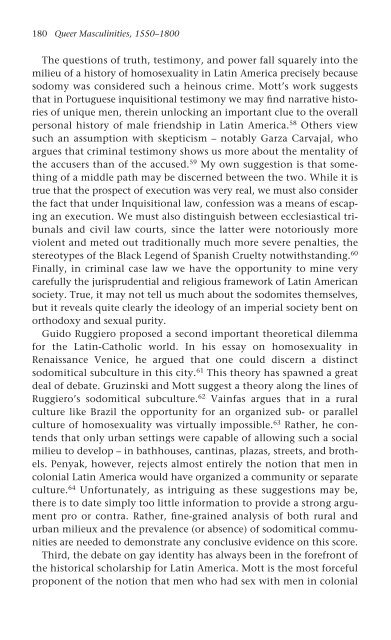queer masculinities
queer masculinities
queer masculinities
Create successful ePaper yourself
Turn your PDF publications into a flip-book with our unique Google optimized e-Paper software.
180 Queer Masculinities, 1550–1800<br />
The questions of truth, testimony, and power fall squarely into the<br />
milieu of a history of homosexuality in Latin America precisely because<br />
sodomy was considered such a heinous crime. Mott’s work suggests<br />
that in Portuguese inquisitional testimony we may find narrative histories<br />
of unique men, therein unlocking an important clue to the overall<br />
personal history of male friendship in Latin America. 58 Others view<br />
such an assumption with skepticism – notably Garza Carvajal, who<br />
argues that criminal testimony shows us more about the mentality of<br />
the accusers than of the accused. 59 My own suggestion is that something<br />
of a middle path may be discerned between the two. While it is<br />
true that the prospect of execution was very real, we must also consider<br />
the fact that under Inquisitional law, confession was a means of escaping<br />
an execution. We must also distinguish between ecclesiastical tribunals<br />
and civil law courts, since the latter were notoriously more<br />
violent and meted out traditionally much more severe penalties, the<br />
stereotypes of the Black Legend of Spanish Cruelty notwithstanding. 60<br />
Finally, in criminal case law we have the opportunity to mine very<br />
carefully the jurisprudential and religious framework of Latin American<br />
society. True, it may not tell us much about the sodomites themselves,<br />
but it reveals quite clearly the ideology of an imperial society bent on<br />
orthodoxy and sexual purity.<br />
Guido Ruggiero proposed a second important theoretical dilemma<br />
for the Latin-Catholic world. In his essay on homosexuality in<br />
Renaissance Venice, he argued that one could discern a distinct<br />
sodomitical subculture in this city. 61 This theory has spawned a great<br />
deal of debate. Gruzinski and Mott suggest a theory along the lines of<br />
Ruggiero’s sodomitical subculture. 62 Vainfas argues that in a rural<br />
culture like Brazil the opportunity for an organized sub- or parallel<br />
culture of homosexuality was virtually impossible. 63 Rather, he contends<br />
that only urban settings were capable of allowing such a social<br />
milieu to develop – in bathhouses, cantinas, plazas, streets, and brothels.<br />
Penyak, however, rejects almost entirely the notion that men in<br />
colonial Latin America would have organized a community or separate<br />
culture. 64 Unfortunately, as intriguing as these suggestions may be,<br />
there is to date simply too little information to provide a strong argument<br />
pro or contra. Rather, fine-grained analysis of both rural and<br />
urban milieux and the prevalence (or absence) of sodomitical communities<br />
are needed to demonstrate any conclusive evidence on this score.<br />
Third, the debate on gay identity has always been in the forefront of<br />
the historical scholarship for Latin America. Mott is the most forceful<br />
proponent of the notion that men who had sex with men in colonial


